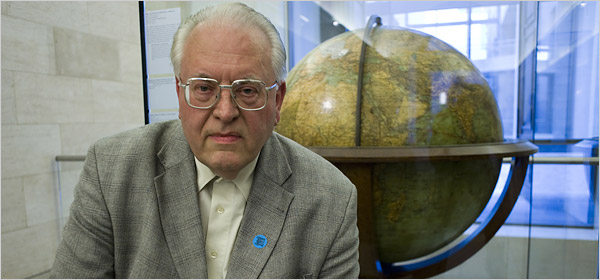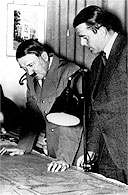
September 18, 2007 Abroad 
The
Mystery of Hitler's Globe Goes Round and
Round By Michael
Kimmelmann BERLIN, Sept. 16 --
Hitler's globe is
missing. Wolfram Pobanz,
a 68-year-old retired cartographer, is
positive that it's not the one in the
Deutsches Historisches Museum, with the
Russian bullet hole through Germany, and
he can prove it. Neither is it the one in the
Märkisches Museum, the Berlin history
museum nearby, nor the one in a
geographical institute across town, which
first caught Mr. Pobanz's eye 40-odd years
ago when he was a student.  "We
called it the Führer globe," he
remembered. It planted the seed of his
fascination with the Columbus Globe for
State and Industry Leaders, as this
enormous model was called -- a far cry
from the inflatable version that
Charlie Chaplin bounced around in
"The Great Dictator," which mocked
Hitler's megalomania and created the
indelible vision of a fascist tyrant doing
a pas de deux with the planet. "We
called it the Führer globe," he
remembered. It planted the seed of his
fascination with the Columbus Globe for
State and Industry Leaders, as this
enormous model was called -- a far cry
from the inflatable version that
Charlie Chaplin bounced around in
"The Great Dictator," which mocked
Hitler's megalomania and created the
indelible vision of a fascist tyrant doing
a pas de deux with the planet.
Manufactured in two limited editions in
Berlin during the mid-1930s (the second
edition changed Abyssinia to Italian East
Africa), the real Columbus globe was
nearly the size of a Volkswagen and, at
the time, more expensive. A standard wood
base was designed to support it, but
custom furniture stands were made for
Hitler and other Nazi leaders. Mr. Pobanz
has been methodically tracking them
down. White-haired, large, jowly and
bespectacled, an unstoppable St. Bernard
of enthusiasm for all things
globe-related, he came the other day to
the Deutsches Historisches Museum with a
stack of books and photocopied evidence in
his satchel, happy to lay it all out. "He's a very serious man with a passion
for this particular type of globe," said
the museum's director, Hans
Ottomeyer. Mr. Ottomeyer had mentioned
Mr. Pobanz in passing during a
conversation about Berliners with
remarkable obsessions. Mr. Pobanz's
full story turns out to be a mystery.
Besides the globes in Berlin, he said,
there are two Columbus globes in public
collections in Munich. Fellow globe
hunters, put on the scent by word of
his pursuit, have turned up several
more in private hands and elsewhere,
outside Germany. None, however, is from
Hitler's office in the New Reich
Chancellery, the globe that inspired
Chaplin. In Chaplin's satiric film the globe is
a balloon, an emblem of megalomania, which
suddenly bursts in the fictional tyrant's
face. The image became a cinematic
touchstone: art transformed into political
symbol, shaping history.  Hitler,
more than any modern tyrant, grasped the
power of visual signs. He cooked up the
Nazi Party uniform and the flag and hired
Albert Speer (with Hitler,
right) to design the New Chancellery,
where the giant Columbus globe, with a
sharp-cornered, stepped wood base, was
parked in Hitler's quarters. Newsreels and
still photographs from the time the
building opened, in 1939, show visitors
trekking down marbled passageways more
than four football fields long to reach
the Führer. It was Chaplin's genius,
in 1940, to exploit the symbolism of the
globe. Hitler,
more than any modern tyrant, grasped the
power of visual signs. He cooked up the
Nazi Party uniform and the flag and hired
Albert Speer (with Hitler,
right) to design the New Chancellery,
where the giant Columbus globe, with a
sharp-cornered, stepped wood base, was
parked in Hitler's quarters. Newsreels and
still photographs from the time the
building opened, in 1939, show visitors
trekking down marbled passageways more
than four football fields long to reach
the Führer. It was Chaplin's genius,
in 1940, to exploit the symbolism of the
globe.
"It has been a trait of megalomaniacs
throughout history to use the arts to
control thought, gain respectability,
bolster their power and memorialize
themselves," Frederic Spotts, a
historian of modern Germany, observes in
his book "Hitler and the Power of
Aesthetics." But Hitler went "beyond the
others," he writes, and "defined and
legitimized his rule in cultural
terms." Chaplin's sight gag, you might say,
gained weight precisely by playing off
Hitler's use of visual symbols. Funny thing is, "Hitler probably didn't
think anything about the globe," Mr.
Pobanz said. "There's no picture of Hitler
beside the globe. He controlled all
photographs of himself. If the globe had
actually meant anything special to Hitler,
there would surely be a photograph." "For me this is not about Hitler, it's
about the correctness of the situation,"
he insisted. When a Berlin newspaper last
year called the Deutsches Historisches
Museum's globe "the
Globe of the Mass Murderer," he
simply felt, as a scholar, that the record
should be set straight. Whether he would
be going to the same lengths to uncover
the pedigree of a globe attributed to
Konrad Adenauer or John Foster
Dulles, he didn't say. Instead, he said, "I don't know how
many of these globes were made because the
Columbus factory was destroyed in 1943,
along with its archives." Mr. Pobanz
pulled out a photocopy of a drawing he had
unearthed for a custom base, designed by
the Munich studio of Paul Ludwig
Troost. Troost was Hitler's favorite
architect during the early 1930s. "This
base was made for Ribbentrop's
Foreign Ministry," he said. It was identical to the one for the
globe at the Deutsches Historisches
Museum. "So this globe could only have
been made for Ribbentrop," he said. He did not pause to contemplate if the
provenance made much difference, morally
speaking. "The globes designed for the New
Reich Chancellery had a more angular
base," he said, then unveiled a different
photocopy. About the two globes in Munich, he
explained, one came from Hitler's offices
there (also with a bullet hole in it,
American). So that is a Hitler globe, but
it's still not the model ordered by Speer
for the New Reich Chancellery, which
Chaplin immortalized. The second globe in
Munich came from a Nazi administrative
building. Both pedigrees are documented,
Mr. Pobanz said. He then leapt into a list of
international globe organizations. Mr.
Pobanz belongs, he explained, to the
International Coronelli Society for the
Study of Globes, through which "I've heard
about a globe in Breslau, and another in
Warsaw." Meanwhile Globusfreund (Friend of
the Globe) magazine, based in Vienna, he
said, has been pressing him to publish his
research. The unmistakable anxiety of a
man contemplating a prospective deadline
suddenly flashed across his face. "I can't," he said. "I'm still
collecting evidence." First interested in maps and globes
because of their artistry and technical
complexity, as a boy he made field trips
in Germany and long bicycle tours across
Europe. "Maps contain the imagination of
the world," he said. "You can't go to all
the places, but you can travel in your
mind." He lives alone, he said. He has no
family. Before tackling this Hitler globe
mystery, he specialized in maps from the
Soviet Union and East Germany, tracking
down errors planted to throw off enemies
from military sites. The suggestion that
he's a map detective seems to offend his
sensibility. He opened a blue folder of papers to a
photocopy showing a group of Russian
soldiers in the New Reich Chancellery in
May 1945, crowded around Hitler's globe.
"I don't know where it is," he said,
studying the image for a second. "Maybe it's in Moscow." 
 Hitler
index
Hitler
index-
|